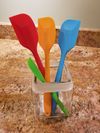I've been baking pies lately, and want to share some pie recipes. Half-size pies, as it turns out, are adorably cute as well as delicious. In writing up the recipes, I realized it would simplify matters if I just put out a basic pie crust recipe. This, or the gluten-free version that will follow shortly, are what I use all the time, for all kinds of dessert pies, as well as savory quiches.
This recipe is about as basic as it gets, and these days looks distinctly old-fashioned. Vegetable shortening (I use Crisco) has a bad name these days. "Englightened" cooks are using lard or butter or some lard-butter mixture. I'm sure they are delicious, too. But the fact is, I watched my mother and my grandmothers struggle with lard pie crusts for years. They were never happy with how they turned out, and honestly, I never liked how they tasted. Once I mastered pie crust made with vegetable shortening, I never looked back.
The general idea of pie crust is to have tiny lumps of fat coated with flour, with enough water to bind the whole thing together. During baking, the fat melts and the water forms steam. This combination makes the pie crust light and flaky, but still strong enough to support the pie.
Notes
This pie crust is not gluten-free. Making gluten-free pie crust requires a whole different approach, so I decided to make that a separate recipe.
The pie crust should be chilled for at least 30 minutes before rolling out. I often make the crust the day before I make pies, and let it chill overnight.
The amount of shortening looks odd: I find that 1/3 C is not quite enough, but 1/2 C is too much. I often measure out 1/3 C and then add an extra dollop, and that seems to work well.
Pie crust is not hard to make, but it may take a little practice. The trickiest part is incorporating just the right amount of water, without over-working the dough. (Over-handling the dough will create a pie crust that is hard and chewy, rather than flaky.) As luck would have it, the exact amount of water needed will vary depending on the moisture content of your flour: flour that has been stored for a while is probably drier than flour that is fresher, so you can't use exactly the same amount of water every time. If the pie dough seems crumbly and does not hold together well, chances are it needs a little more water.
If your dough does not have enough water, it will tend to crack apart when you roll it out. If your dough has too much water, it will be sticky and hard to handle. This is actually easier to deal with, by using a lot of flour on the work surface and the rolling pin itself, and maybe sprinking a little flour on the top of the dough as well.
Inspiration
I learned to make pie crust from a paperback Betty Crocker cookbook when I was in college. Over the years, I have tinkered with the basic recipe. I found the original recipe made just barely enough dough to line a pie pan, which works fine for an experienced baker, but can be frustrating for a beginner to deal with. I increased all the ingredients a bit, which often means I trim off and throw a little away in the end, but I find that's better than not having quite enough. I also increased slightly the proportion of shortening in the recipe, as I think this makes a crust that is easier to handle and flakier to eat.

Comments powered by Talkyard.